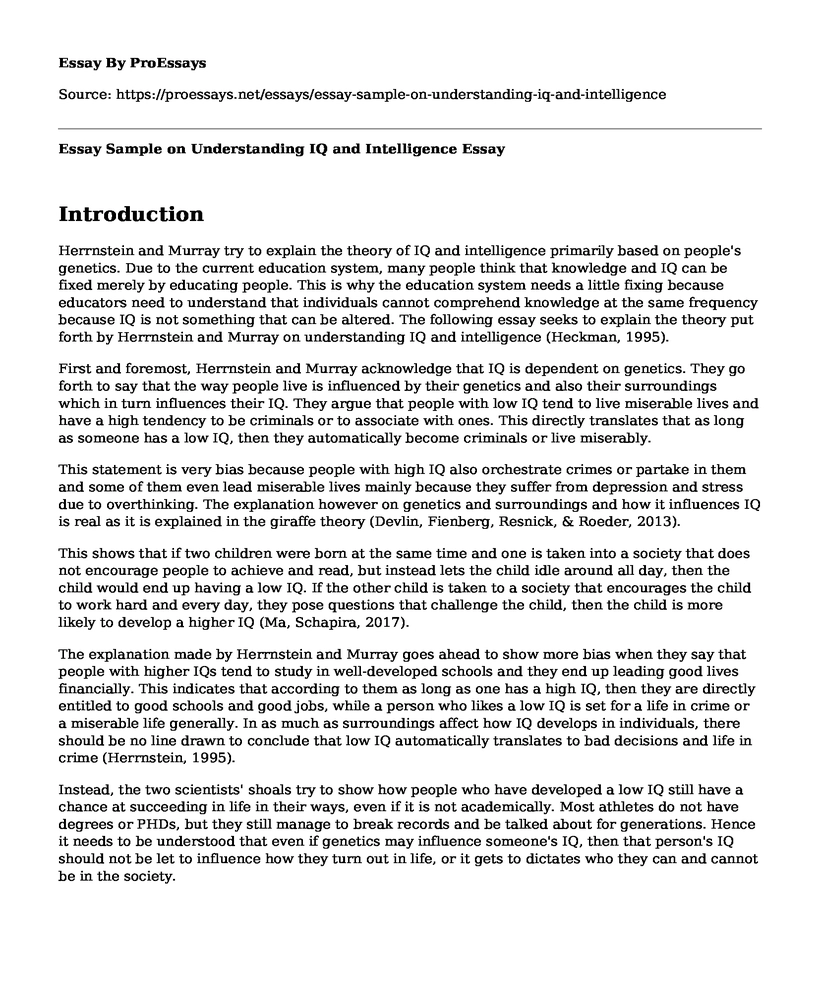Introduction
Herrnstein and Murray try to explain the theory of IQ and intelligence primarily based on people's genetics. Due to the current education system, many people think that knowledge and IQ can be fixed merely by educating people. This is why the education system needs a little fixing because educators need to understand that individuals cannot comprehend knowledge at the same frequency because IQ is not something that can be altered. The following essay seeks to explain the theory put forth by Herrnstein and Murray on understanding IQ and intelligence (Heckman, 1995).
First and foremost, Herrnstein and Murray acknowledge that IQ is dependent on genetics. They go forth to say that the way people live is influenced by their genetics and also their surroundings which in turn influences their IQ. They argue that people with low IQ tend to live miserable lives and have a high tendency to be criminals or to associate with ones. This directly translates that as long as someone has a low IQ, then they automatically become criminals or live miserably.
This statement is very bias because people with high IQ also orchestrate crimes or partake in them and some of them even lead miserable lives mainly because they suffer from depression and stress due to overthinking. The explanation however on genetics and surroundings and how it influences IQ is real as it is explained in the giraffe theory (Devlin, Fienberg, Resnick, & Roeder, 2013).
This shows that if two children were born at the same time and one is taken into a society that does not encourage people to achieve and read, but instead lets the child idle around all day, then the child would end up having a low IQ. If the other child is taken to a society that encourages the child to work hard and every day, they pose questions that challenge the child, then the child is more likely to develop a higher IQ (Ma, Schapira, 2017).
The explanation made by Herrnstein and Murray goes ahead to show more bias when they say that people with higher IQs tend to study in well-developed schools and they end up leading good lives financially. This indicates that according to them as long as one has a high IQ, then they are directly entitled to good schools and good jobs, while a person who likes a low IQ is set for a life in crime or a miserable life generally. In as much as surroundings affect how IQ develops in individuals, there should be no line drawn to conclude that low IQ automatically translates to bad decisions and life in crime (Herrnstein, 1995).
Instead, the two scientists' shoals try to show how people who have developed a low IQ still have a chance at succeeding in life in their ways, even if it is not academically. Most athletes do not have degrees or PHDs, but they still manage to break records and be talked about for generations. Hence it needs to be understood that even if genetics may influence someone's IQ, then that person's IQ should not be let to influence how they turn out in life, or it gets to dictates who they can and cannot be in the society.
Conclusion
In addition to that, their theory tries to favor the person with high IQ but giving them all the positive praise. The giraffe theory explained is an excellent example to show that a shift in surroundings can turn a person with a high IQ to a low IQ and vice versa. Hence when a person is imprisoned, one should not automatically conclude that their IQ is small, but one should try to understand that different factors can make someone commit a crime. Furthermore, a low IQ does not influence whether a person will be rich or poor (Kincheloe, Steinberg, & Gresson, 1997).
References
Devlin, B., Fienberg, S. E., Resnick, D. P., & Roeder, K. (Eds.). (2013). Intelligence, genes, and success: Scientists Respond to The Bell Curve. Springer Science & Business Media.
Heckman, J. J. (1995). Lessons from the bell curve. Journal of Political Economy, 103(5), 1091-1120.
Herrnstein, R. J. (1995). The bell curve debate: History, documents, opinions. R. Jacoby, & N. Glauberman (Eds.). New York: Times Books.
Ma, C., & Schapira, M. (2017). The bell curve: Intelligence and class structure in American life. Macat Library.
Kincheloe, J. L., Steinberg, S. R., & Gresson III, A. D. (1997). Measured Lies: The Bell Curve Examined. St. Martin's Press, Scholarly and Reference Division, 175 Fifth Avenue, New York, NY 10010 (paperback: ISBN-0-312-12929-7, $17.95; clothbound: ISBN-0-312-12520-8).
Cite this page
Essay Sample on Understanding IQ and Intelligence. (2022, Nov 21). Retrieved from https://proessays.net/essays/essay-sample-on-understanding-iq-and-intelligence
If you are the original author of this essay and no longer wish to have it published on the ProEssays website, please click below to request its removal:
- Physics Lab Report Example on Density, Mass, and Volume
- Physics Essay Example: Circulation Motion, Torque, Centripetal Force
- Magnetic Timer Case Study
- The Effect of Geography - Essay Sample
- Proofs and Disproof's of the Big Bang Theory Essay
- Research Paper on Exploring the Development of Early Cities: The Archeology of Jericho and Catalhoyuk
- Paper on Uncovering the Past: Archeology, Social-Scientific Criticism, and Historical Criticism







